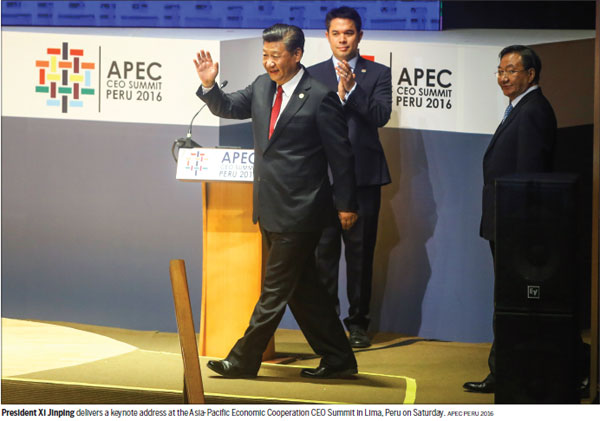Chinese – Latin America trade: An evolution of significance

The recent visit of President Xi Jinping to a number of Latin American countries during this year’s APEC summit in Peru signifies seemingly important developments in the international trade policy of China. Last year’s Chinese investment in Latin America surpassed $126 billion with enormous forthcoming prospects arising out of sectoral needs in infrastructure, network industries and information technology.
Latin America represents a strategic milestone for China’s economic plans. China has been a vocal proponent and driving force of APEC, which intends to create an institutional platform for trade liberalization outside the WTO remit. APEC envisages deepening the principles of free trade enshrined by WTO by utilizing Free Trade Agreements, which are trade frameworks that go deeper in trade liberalization than the reciprocity principle upon which WTO is founded.
President Xi Jinping, during his visits, projected an image of a global power leader who is fully versed with the benefits of free trade. He said that part of his immediate priorities is to give greater access to foreign investment and continue establishing high standards pilot zones for free trade of APEC signatories in China. His plan is to guarantee the existence of an equal playing field by creating an environment in line with international standards for all businesses in China, both domestic and foreign.
The 2016 APEC meeting reveals three facets of the Chinese international trade policy which are inter-linked and serve each other effectively. These facets cover plurilateralism, as a modality of structuring international trade deals, the Chinese transitory investment strategy and the agenda of renminbi internationalization.
Plurilateralism
Free trade between China and Latin American countries could be based upon plurilateral relations rather than multilateral and bilateral structures. This development has a significant implication: bilateralism, and to a large degree multilateralism in international trade takes into account country-specific priorities, avoiding the effort for finding common denominators which are often seen in plurilateral trade agreements, and seems to dilute free trade principles, perpetuating protectionism and non-tariff barriers.
President Xi pledged a new era of economic cooperation during this year’s APEC summit in Peru. He has been promoting an alternate vision for regional trade by the Beijing-backed Regional Comprehensive Economic Partnership (RCEP). China believes that building a free trade area of the Asia-Pacific is a strategic initiative critical for long-term prosperity.
China is the world’s second largest economy and stands to play a more prominent role as far as trade in Asia Pacific is concerned through a plurilateral trade mode.
Transitory investment strategy
We are currently witnessing the transition of a Chinese investment strategy from an economic plan which focused on traditional industries, energy and infrastructure and which has been served through sovereign funds to an economic plan which focuses on services and high value interests, which are served primarily through private capital. The modality of such transitions is the role of private equity and of institutional investors. The Chinese transitory investment strategy could be best served through plurilateralism and free trade agreements, which do not differentiate sectoral growth patterns and apply particular priorities on predetermined policies of signatory member states. This appears to be one of the most prolific trends for the years to come and reveals the private sector prioritization on investment and free trade agreements which are based on plurilateral structure.
Renminbi internationalization
Chinese investment and free trade policies are indissolubly linked with the agenda of renminbi internationalization. Trade deals with Latin American states and enhancing the remit of APEC can only facilitate the objective of renminbi internationalization.
For the first time, the relevance of APEC has been widely felt as well as the influence of China over future international trade deals interface. Free trade is the only way to ensure sustainable growth, where market access and uninhibited movement of production factors ensure prosperity. Free trade in its genuine projection can be facilitated through plurilateral structures which are transparent, collective and inclusive.
The author is a professor of EU and International Business Law at the Hull Business School, University of Hull.

























